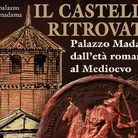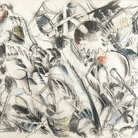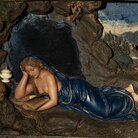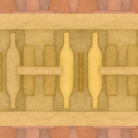Titian: Love Desire Death
Dal 16 March 2020 al 14 June 2020
Londra |
Luogo: National Gallery - Main Floor Galleries
Indirizzo: Trafalgar Square, Charing Cross, London WC2N 5DN
Orari: Tutti i giorni 10 - 18 (Ultimo ingresso h 17) | Ven 10 - 21 (Ultimo ingresso h 20.15)
Curatori: Matthias Wivel
Enti promotori:
- Liberty Specialty Markets
- Supportato da: Moretti Fine Art Ltd
- The Vaseppi Trust
- Andrew Bentley and Fiona Garland
- Katherine Stemberg and Bill Schnoor
- Il Circolo Charity – Italian Cultural Association
- Bernard Sunley Foundation
Costo del biglietto: Biglietto standard: Lun - Ven £ 10 / Sab - Dom £ 12 | Prenotazione online £ 2 | Ingresso libero per i Soci
Telefono per informazioni: +44 20 7747 2885
E-Mail info: information@ng-london.org.uk
L'epica serie di dipinti mitologici di grandi dimensioni di Tiziano, conosciuta come le poesie, sarà riunita per la prima volta dalla fine del XVI secolo alla National Gallery il prossimo marzo.
Dal ciclo originale di sei dipinti, la mostra riunirà Danaë (1551-1553, The Wellington Collection, Apsley House); Venere e Adone (1554, Prado, Madrid); Diana e Atteone (1556-1559) e Diana e Callisto (1556-1559), di proprietà congiunta della National Gallery e delle National Galleries of Scotland; e il Ratto di Europa (1562) recentemente conservato dall'Isabella Stewart Gardner Museum di Boston.
In seguito alla decisione storica di prestare temporaneamente le opere per la prima volta nei suoi 119 anni di storia, la Collezione Wallace presterà alla mostra in Trafalgar Square il dipinto del ciclo, Perseo e Andromeda, (1554-1556).
Sarà esposta anche La morte di Atteone della National Gallery (1559-1575), originariamente concepita come parte della serie, ma eseguita solo molto più tardi e mai consegnata.

Dipinte tra il 1551 e il 1562 circa, le poesie sono tra le interpretazioni visive ed originali del mito classico della prima era moderna e sono considerate una pietra miliare nella storia della pittura europea per la loro ricca potenza espressiva.
Tutti i dipinti ruotano attorno all'amore e al desiderio: i loro frutti e pericoli. Combinando il notevole talento di Tiziano come artista e narratore, le scene mitologiche catturano momenti di grande drammaticità; un incontro fatale, una vergognosa scoperta, un improvviso rapimento. In questi dipinti Tiziano manipola sapientemente la pittura e il colore con effetti abbaglianti; catturare la carne luminosa, i tessuti sontuosi, i riflessi dell'acqua, oltre a paesaggi suggestivi, quasi incantati. I suoi personaggi mostrano emozioni molto umane e riconoscibili: euforia, preoccupazione, colpa, sorpresa, vergogna, disperazione, angoscia e terrore.
I dipinti raffigurano storie della mitologia classica, principalmente tratte dalle Metamorfosi del poeta romano Ovidio. Poiché li considerava equivalenti visivi alla poesia, Tiziano li definì le sue "poesie". Distillò in loro la conoscenza della pittura e della narrazione visiva che aveva acquisito nel corso di cinque decenni come artista, per creare alcune delle sue dichiarazioni più profonde sulla passione e l'irrazionalità umana, sull'amore e sulla morte. La serie fu commissionata da Filippo II di Spagna, che diede insolitamente a Tiziano un mandato aperto per selezionare i suoi soggetti.
Le lettere tra Tiziano e Filippo mostrano che le poesie fossero pianificate per essere esposte insieme in una singola stanza ma, dal momento che Filippo cambiava costantemente residenza nel corso della sua creazione, è improbabile che il patrono stesse pensando ad una destinazione specifica per il gruppo. I dipinti sono un ottimo esempio un raro accordo tra un mecenate sensibile ed un grande artista, che continua a crescere e ad approfondire la sua visione artistica anche in tarda età.
La commissione fu una svolta nella carriera di Tiziano, offrendogli l'opportunità di approfondire le sue abilità nel mettere in scena narrazioni complesse, gestire emozioni difficili e ambigue e dipingere in modo espressivo per attrarre i sensi.
Poco dopo aver terminato Diana e Atteone, Tiziano iniziò un sequel per Filippo che mostrava la tragica conclusione della storia: La morte di Atteone. Sebbene originariamente avesse concepito questa immagine come parte della serie, non l'inviò mai a Filippo. Ci lavorò più tardi, probabilmente nel 1560 o all'inizio del 1570, ma non sappiamo per chi. L'opera potrebbe essere rimasta nel suo studio fino alla sua morte nel 1576.
L'artista era già noto per i dipinti mitologici che collocano gruppi animati di figure in paesaggi idilliaci. Il suo lavoro rivoluzionario in questo genere fu la straordinaria serie di immagini che fece per Alfonso d'Este, duca di Ferrara, che includeva Bacco e Arianna (1520-1523) ora alla National Gallery.
Delle sei poesie di Tiziano per Filippo II di Spagna, solo due sono rimaste a Madrid, in Spagna: Danaë e Venere e Adone. Danaë rimase più a lungo, ma fu presa da Giuseppe Bonaparte nel 1813 e catturata da Wellington nella battaglia di Vitoria, dopo di che arrivò in Inghilterra. Anche Venere e Adone era in Inghilterra, quando Tiziano lo mandò a Filippo in occasione delle nozze con Maria Tudor (1516-1558).
Gli altri quattro dipinti, Perseo e Andromeda, Ratto di Europa, Diana e Callisto, Diana e Atteone, più l'incompiuto La morte di Atteone, passarono per vie diverse nella collezione di Filippo II, Duca d'Orléans (1674-1723). Quando la raccolta fu messa all'asta a Londra nel 1798, le cinque poesie furono divise ma rimasero nelle collezioni britanniche per tutto il diciannovesimo secolo. Perseo e Andromeda furono invenduti alla prima vendita, e poi cambiarono di mano prima di essere ceduti alla seconda vendita del Duca d'Orléans nel 1805. Tutte le poesie quindi, si sono ritrovate ad un certo punto nel Regno Unito, e Perseo e Andromeda diverse volte, prima quando Van Dyck lo portò a Londra qualche tempo dopo il 1623.
L'eccezionale qualità delle poesie attirò le offerte di ricchi collezionisti all'estero e nel 1896 Ratto di Europa fu venduto a Isabella Stewart Gardner per la sua collezione a Boston, negli Stati Uniti. Tuttavia, Perseo e Andromeda furono assicurati per la Gran Bretagna l'anno successivo come parte del lascito della Collezione Wallace. Nel 1972, quando La morte di Atteone fu messa in vendita, la National Gallery acquistò con successo il dipinto con l'aiuto di fondi governativi e seguendo un appello pubblico a livello nazionale. Nel 2009, la National Gallery e le National Galleries of Scotland acquisirono congiuntamente Diana e Atteone; e nel 2012, Diana e Callisto, assicurando gli ultimi due di questi capolavori per il pubblico.
Il dott. Matthias Wivel, curatore di dipinti italiani del XVI secolo presso la National Gallery e curatore di Tiziano: Love Desire Death, afferma: “Per molti amanti della pittura, questa è la realizzazione di un sogno che una volta era ritenuto impossibile. I dipinti sono così potenti individualmente che trovo difficile sopravvalutare l'effetto di vederli insieme ”.
Il dott. Gabriele Finaldi, direttore della National Gallery, afferma: “Impensabile fino ad oggi, per la prima volta in oltre quattro secoli, grazie al prestito della collezione Wallace di Tiziano Perseo e Andromeda, tutte le poesie mitologiche dell'artista ormai attempato commissionate dal re di Spagna saranno visibili insieme, come da progetto originario. Sono entusiasta che ciò accada alla National Gallery. "
Matthew Moore, Presidente e Amministratore Delegato, Liberty Specialty Markets, afferma: “Siamo orgogliosi di supportare la mostra. Siamo uno dei principali fornitori globali di coperture assicurative speciali per le collezioni di Belle Arti e Specie. Comprendiamo quanto sia importante preservare e prendersi cura di questi pezzi di storia in modo che possiamo goderne e così anche le generazioni future. Questa è un'opportunità irripetibile per poter vedere tutti e sei i dipinti in un unico posto e non vedo l'ora di divertirmi. ”
La mostra approderà alla Scottish National Gallery, Edimburgo (11 luglio - 27 settembre 2020), al Prado, Madrid (20 ottobre 2020-10 gennaio 2021) e all'Isabella Stewart Gardner Museum, Boston (11 febbraio - 9 maggio 2021).
Perseo e Andromeda sono confermati solo per Londra al momento.
La mostra è curata dal dott. Matthias Wivel, curatore dei dipinti italiani del XVI secolo alla National Gallery di Londra.
Mostra organizzata dalla National Gallery, dalle National Galleries of Scotland, dal Museo Nacional del Prado e dall'Isabella Stewart Gardner Museum di Boston.
Leggi anche:
• FOTO - Titian: Love Desire Death
SCARICA IL COMUNICATO IN PDF

-
 Dal 20 December 2025 al 20 April 2026
Caserta | Reggia di Caserta
Dal 20 December 2025 al 20 April 2026
Caserta | Reggia di Caserta
Regine: trame di cultura e diplomazia tra Napoli e l’Europa
-
 Dal 19 December 2025 al 23 March 2026
Torino | Palazzo Madama - Museo Civico d’Arte Antica
Dal 19 December 2025 al 23 March 2026
Torino | Palazzo Madama - Museo Civico d’Arte Antica
Il castello ritrovato. Palazzo Madama dall’età romana al medioevo
-
 Dal 17 December 2025 al 19 January 2026
Roma | Palazzo della Cancelleria
Dal 17 December 2025 al 19 January 2026
Roma | Palazzo della Cancelleria
De Humana Mensura di Linda Karshan
-
 Dal 18 December 2025 al 12 April 2026
Firenze | Gallerie degli Uffizi
Dal 18 December 2025 al 12 April 2026
Firenze | Gallerie degli Uffizi
Cera una volta. Sculture dalle collezioni medicee
-
 Dal 11 December 2025 al 9 April 2026
Firenze | Museo Archeologico Nazionale di Firenze
Dal 11 December 2025 al 9 April 2026
Firenze | Museo Archeologico Nazionale di Firenze
Icone di Potere e Bellezza
-
 Dal 11 December 2025 al 11 January 2026
Roma | Palazzo Esposizioni Roma
Dal 11 December 2025 al 11 January 2026
Roma | Palazzo Esposizioni Roma
Giorgio Morandi nella Collezione Eni. Un viaggio attraverso la storia culturale del cane a sei zampe e l’eredità di Enrico Mattei



